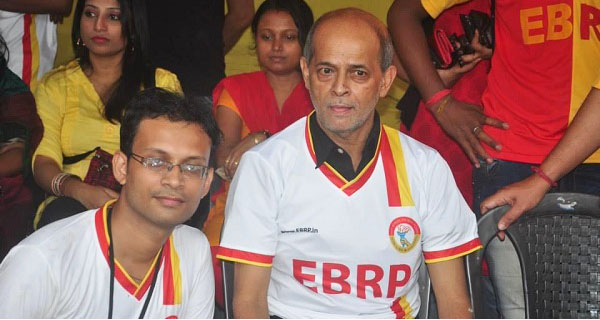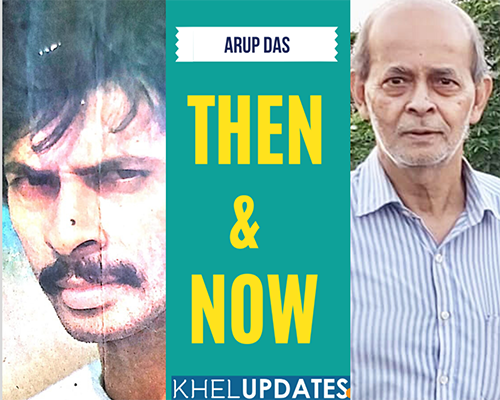Arup’s shy nature was the reason why he missed headlines and glossy photo ops on the several football magazines.
CALCUTTA (India): Born in a 13-member family including nine brothers, two sisters and parents, the least that Arup Das could think of was playing football.
Karimganj in Assam wasn’t any Bengal district where football was the be-all and end-all of the youths in the 1960s and 1970s.
However, following his elder brother’s (Ajay) footsteps, the young and introverted Arup fell in love with the sport despite the financial constraint that his family had to fight with in their daily lives – his sisters stitched sarees while his parents strived against all odds to make ends meet.
Surprisingly, the Indian football fans and followers never knew much about this modest footballer, who played at Mohun Bagan, East Bengal and Mohammedan Sporting and Team India from 1981 to 1989.
Arup remained a recluse. He wasn’t and still isn’t media savvy, and hence not much has been written on this outstanding striker.
No wonder his shy nature was the reason why he missed headlines and glossy photo ops on the several top football magazines in vogue in Calcutta in the 1970s and 1980s.
“I never liked publicity. It wasn’t and still isn’t my taste at all,” said Arup, who has recently retired from Steel Authority of India.
“I preferred to stay aloof after my football career was over. I never went to the three clubs I had played for. You can say, I never liked.”
But he has decided to shed his image a bit, and joined the social networking site.
He was overwhelmed with the responses he received from Bagan, East Bengal and Mohammedan fans.
“I thank #MohunBagan #MohammedanSporting #EastBengal for giving me the opportunity to don their iconic jerseys and to their fans for their love and affection, and also to the All India Football Federation for turning out in national colours,” he wrote.
Early years
Arup started his career with Guwahati Maharana Club in 1977, and then turned out for Guwahati Town Club a year later.
But as was the cliché then, ‘Your football knowledge is incomplete if you don’t play in Kolkata,’ Arup landed in the City of Joy in 1979.

For a rookie, it wasn’t an easy task to settle down in the cacophony of Maidan. Arup, who has always been calm and composed, took to the grinds step by step.
He was enrolled in Railways Football Club, and thus his journey was kicked off in a city which he never left.
Arup overcame the initial hitches that’s associated with a struggling footballer.
“I stayed in a small room at Sealdah in central Calcutta,” he said. “Managing proper meals was a difficult proposition, and the back-breaking trainings thrice daily rendered me physically weak at times, but Dada motivated and encouraged me a lot during those struggling days.”
But his performances with Railway FC caught the eye of the late coach PK Banerjee.
“I’ll forever be thankful to him for showing me the way. If you ask me, he was the best Indian coach I’ve played under,” said Arup, who joined Mohun Bagan in 1981.
Talent doesn’t go unnoticed, and despite getting fewer matches in the Calcutta League, Arup left an indelible impression.
‘Not a single club awarded me’
Arup was soon inducted into the Bengal team for Santosh Trophy (National Football Championship) and national team.
“My best performance was the IFA Shield final against East Bengal in 1981. I scored the only goal for Bagan,” he said.
He also fondly remembers his stint at Mohammedan Sporting for whom he played four seasons (1985-1987 and 1989).
“I really enjoyed my time at Mohammedan. The fans loved me a lot,” Arup added.
Asked if he remembers any of the matches for the Black and White, he said: “The 1987 Rovers Cup final against Mohun Bagan will be ranked as one of my memorable matches.”
For the first time, Arup spoke about the lack of acknowledgement from the clubs he had played for.
“I’ve given my best years at Mohammedan besides the other clubs. But I haven’t received no awards from the club though they’ve given to most players who had hardly played for them long,” he added.
Boby Moore and Ciric Milovan

Arup’s exploits with the Green and Maroon side (1981 & 1984) and later East Bengal (1982, 1983 and 1988) earned him a place in the national team.
The then India coach Ciric Milovan was so impressed with Arup that he put him in left-half position at the 1984 Nehru Cup in Calcutta.
“He (Milovan) was a great tactician. He had different thought process and introduced India to the modern football. I became a very effective player under him. In my opinion, he was the best foreign coach to have plied his trade in the country,” he said.
(With inputs from Debjani and Alakananda Das)












Inspirational